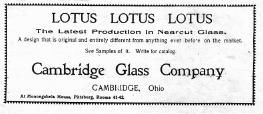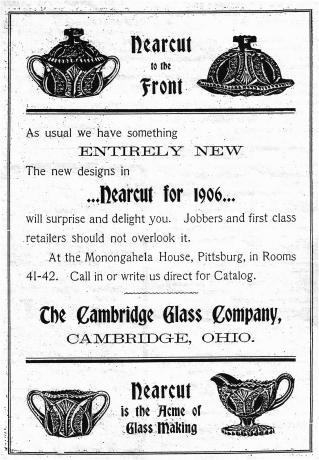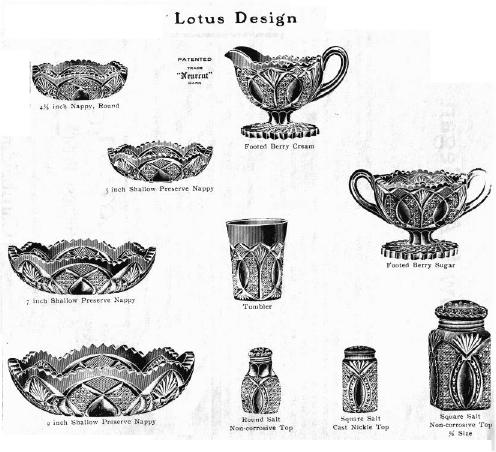How It All Began, Part II
by Mark Nye
Issue No. 281 - September 1996
"THE MERRY SALESMEN ARE NOW HERE" read a headline in the January 6, 1906 issue of China, Glass, and Lamps. The secondary caption continued on with this statement:
"With lines of glass and pottery they have taken possession of the city - exhibits are more scattered than heretofore - some exceedingly original patterns may be seen - several pottery firms represented for the first time - indications that this will be the banner year."
Then followed an article on the opening of the January 1906 Pittsburg Glass & Pottery Exhibit. Among the exhibitors was the Cambridge Glass Company in rooms 41 and 42 of the Monongahela House. Representing the company was its president, Arthur J. Bennett.
This same issue (Jan. 6, 1906) of CGL had this short news item.
"A. J. Bennett is at the Monongahela House in rooms 41-42. He has with him a full display of the Cambridge Glass Co.'s line. Their famous 'Near-Cut' pattern obtained the highest award at the St. Louis Exposition and has been in great demand. Mr. Bennett has some additions to these lines and promises that this year's patterns will create even a greater furor."
The St. Louis Exposition was held in 1904 and a Silver Medal was awarded to the Cambridge Glass Company in recognition of the quality of its glass, rather than any one line or design. A later Cambridge catalog contained a reprint of the certificate that accompanied the medal. Below it was printed the statement: " 'Nearcut' Glass was awarded the Highest Premium at St. Louis, 1904."
Another article published in CGL regarding the 1906 Pittsburg show was entitled "WHAT THE SALESMEN ARE SHOWING" and while written as a conversation between two or more individuals, it does contain valuable information.
"I say, though, Bill, did you see the new lines of 'Nearcut' glass made by the Cambridge Glass Co.?"
"I most certainly did, and I want to say most emphatically that the new Lotus line is a beauty. This is an entirely new design and it
is going to be, in fact, is, a winner. Bear in mind it is not a reproduction of anything in cut glass. The majority of those producing imitation cut glass take a piece of the real article, have a plaster cast made and go ahead and make their pressed line. The Lotus line is entirely different from these. You will not find its facsimile in cut any place on the market. Mr. Bennett drew his own design, had a piece of glass cut from it and produced the Lotus line accordingly. It is in every sense original and it is also original in the manner of design of imitation cut."
These same two individuals also went on to talk about Marjorie:
"The Marjorie pattern will always stand high. Those that handled it before, will do so again and yet again. It is original in shape and pattern, has the weight and proper brilliancy and is, in a word, elaborate."
And Fernland:
"Mr. Bennett showed me a line which he said was a lower-priced one, but no one would ever know it. He calls it Fernland, probably on account of the design, as he says it is low in cost but high in quality and finish and a ready seller."
(Both Fernland and Marjorie were illustrated in last month's issue.)
An advertisement published in the January 1906 issue of Glass & Pottery World read in part:
"Our Marjorie design for season 1905 has not yet been equalled in design, brilliancy and finish and remains unequalled as a seller and profit maker but we shall present an entirely new design for 1906 which is of novel style of cutting, and which must create a field of its own. It is original, has character and style, and is a success from the start. Compare it with any other and you will buy it."
 The new design for 1906 the ad referred to was Lotus.
The new design for 1906 the ad referred to was Lotus.
The Lotus pattern was illustrated in a 10 page booklet issued by the Cambridge Glass Co. early in 1906. The publication of this booklet was noted in Glass & Pottery World.
"No better booklet has ever been gotten out for the trade than the ten-page illustrated price list devoted to the Lotus Line of pressed table ware made by the Cambridge Glass Co. . . . The cuts shown of this easy rapid selling line are in excellent taste and have an originality all their own . . ."
The May 1906 issue of Glass & Pottery World had this short item regarding the Lotus line:
"The Lotus line of tableware has proven to be all that the Cambridge Glass Company claimed for it, and the sales have been excellent, considering the somewhat dull market which has prevailed during April and May."
A full Cambridge advertisement appeared in the 1906 holiday issue of Crockery and Glass Journal. It contained an illustration of the Cambridge factory buildings and one of a Feather nappy or bowl. Part of the text read:
"We make Bar Glassware, Candy Trays, Candy Jars, Show Jars, Tableware, Tumblers, Cup-foot Stemware."
It also listed under the heading "Nearcut Designs" these patterns: Marjorie, Dorothy, Sunburst, Fernland, and Paul Revere. Note the absence of Lotus in this listing. Whether or not this means Lotus had already been discontinued, less than a year after its introduction, cannot be conclusively determined.
Illustrating this article are two pages from the Lotus booklet and three advertisements from China, Glass and Lamps. The full-page advertisement, while showing pieces of Lotus, does not mention it by name and appeared in December 1905. The other two that refer to Lotus by name appeared in January 1906 issues.


